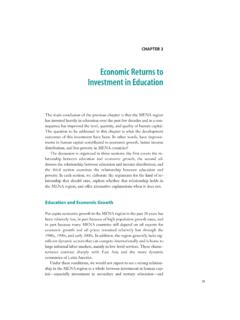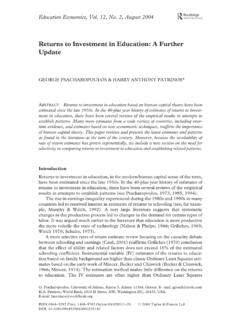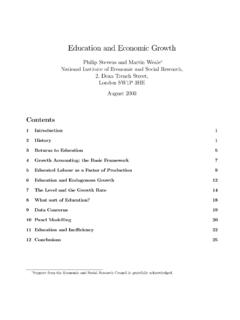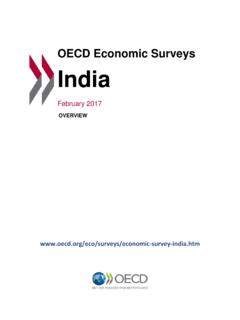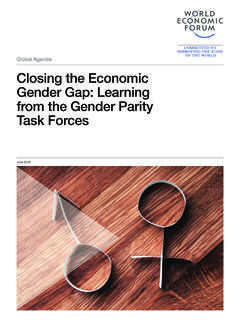Transcription of MAKING WATER A PART OF ECONOMIC DEVELOPMENT
1 MAKING WATER A part OF ECONOMIC DEVELOPMENTThe ECONOMIC Benefi ts of Improved WATER Management and ServicesA report commissioned by the Govern-ments of Norway and Sweden as in-put to the Commission on Sustainable DEVELOPMENT (CSD) and its 2004 2005 focus on WATER , sanitation and related MAKING WATER a part of ECONOMIC DevelopmentContentsNote to the Reader .. 3 Five Important Messages .. 41 Introduction .. Why the Urgency? Benefi ts for People, Environment and Business .. 92 Generating ECONOMIC Benefi ts With Improved WATER Resources Management and Services .. Improved Access to WATER Services and Basic Sanitation for ECONOMIC DEVELOPMENT .
2 Immediate Benefi ts of Improved Human Health .. Long-term Benefi ts of Improved Education and Health .. WATER Resources Management for ECONOMIC DEVELOPMENT .. Agricultural and Food Production .. Industrial DEVELOPMENT .. WATER Storage and Hydropower Infrastructure .. Ecosystem Goods and Services .. Floods and Droughts and the Economy .. 253 How Much Does it Cost to Act? .. Improving Access to WATER Supply and Sanitation .. Global Level Cost Estimates .. Country and Local Level Cost Estimates .. Improving WATER Resources Management and WATER Infrastructure .. 294 ECONOMIC Cost-benefi t Analysis.
3 WATER and Sanitation .. WATER Resources Management .. Unproductive Costs the Burden of Corruption .. 385 Conclusions: Investing in WATER is Good Business .. What are the Ways Forward? .. 43 Notes .. 45 Bibliography .. 46 List of TablesTable Value of aquatic ecosystem WATER services.. 24 Table Resource requirements for reaching MDG WATER and Sanitation Target in five low-income countries, 2005 2015 .. 27 Table ECONOMIC benefits arising from WATER and sanitation improvements.. 33 Table Cost-benefit ratios and total ECONOMIC benefits for four interventions .. 34 List of FiguresFigure WATER requirement equivalent of main food products.
4 16 Figure The dependency of the Zimbabwe economy on rainfall (1970 to 1990) .. 17 Figure Africa s infrastructure gap: WATER storage per person in cubic metres .. 22 Figure WATER storage investments required in Africa.. 29 List of BoxesBox 1 Target 10 and Poverty-Related Challenges 10 Box 2 Dengue and Dengue Haemorrhagic Fever .. 12 Box 3 Schistosomiasis .. 13 Box 4 Trachoma .. 13 Box 5 What is a DALY? .. 13 Box 6 Virtual WATER and Trade .. 18 Box 7 WATER Related Disasters and the Cost to the Global Economy .. 25 Box 8 Net Present Value of WATER Supply and Sanitation Interventions .. 35 Box 9 Better WATER Resources Management Ben-efits Health and Economy.
5 37 MAKING WATER a part of ECONOMIC DevelopmentFor the 13th meeting of the Commission on Sustainable DEVELOPMENT (CSD 13) the Norwegian and Swedish Governments commissioned the Stockholm Internation-al WATER Institute (SIWI) to produce the report entitled MAKING WATER a part of ECONOMIC DEVELOPMENT : The ECONOMIC Benefi ts of Improved WATER Management and Services. A collaborating partner for the report has been the World Health Organization (WHO). In MAKING its case, the report focuses on the eco-nomic benefi ts of actions that address the insuffi cient supply of WATER and sanitation services and inadequate WATER resources management. The report also brings to the forefront direct and indirect costs related to inaction, the costs of action and cost-benefi t comparisons.
6 The authors of the report were Mr. Mark Sanctuary (Consultant) and Mr. H kan Tropp (SIWI). The con-tributing author was Ms. Laurence Haller (WHO). The authors are indebted to the special input provided by Mr. Jamie Bartram and Mr. Robert Bos (WHO), Mr. Hans-Olav Ibrekk (The Norwegian Agency for Devel-opment Cooperation, Norad) and Mr. Anders Berntell (SIWI). Graphic and editorial services were provided by Ms. Stephanie Blenckner, Ms. Maria Stenstr m and Mr. David Trouba of SIWI. SIWI graciously acknowledges the Norwegian and Swedish Governments support for their fi nancing of the report. The views expressed in this report are the responsibility of the authors and do not necessar-ily refl ect the views of the Norwegian or Swedish Governments and WHO.
7 This report is a continuation of work prepared for CSD-12 by the Norwegian Government: S. Hansen and R. Bhatia (2004) WATER and Poverty in a Macro- ECONOMIC Context. The report also draws upon a companion report for CSD-13 entitled Sanitation: The Compelling Case to Address the to the ReaderPhoto: Dr. Katrin Teubner MAKING WATER a part of ECONOMIC DevelopmentGood business: that s what investing in improved wa-ter and sanitation and WATER resources management is for national economies and poor people. What s more, the greatest ECONOMIC benefi ts of such invest-ments will be felt in those countries with the greatest WATER challenges.
8 If followed, fi ve urgent but realistic investment messag-es to public and private sector decision makers can help make WATER truly a part of ECONOMIC 1 Improved WATER supply and sanitation and WATER resources management boosts countries ECONOMIC growth and contributes greatly to poverty eradication. Among the world s poor countries, those with ac-cess to improved WATER and sanitation services ex-perience greater ECONOMIC growth. Poor countries with improved access to clean WATER and sanitation services enjoyed annual average growth of Poor countries with the same per capita income but Five Important Messageswithout improved access had an average annual per capita GDP growth of only Message 2 The ECONOMIC benefi ts of improved WATER supply and in particular sanitation far outweigh the in-vestment costs, surprisingly good news for North-ern and Southern decision makers who often view investments as mere costs.
9 ECONOMIC benefi ts ranging from USD 3 to USD 34 per USD 1 invested (depending on the region and technologies applied) would be gained in the health, individual and household, and ag-ricultural and industrial sectors if the WATER and sanitation MDG targets are achieved. Further-more, benefi ts of sanitation investments often are greater than those for WATER interventions. In aggregate, the total annual ECONOMIC benefi ts of meeting the MDG on WATER supply and sani-tation accrue to USD 84 billion. Photo: SIWI MAKING WATER a part of ECONOMIC DevelopmentMessage 3 National economies are more resilient to rainfall variability, and ECONOMIC growth is boosted when WATER storage capacity is improved.
10 Decoupling an economy from rainfall variability promotes gains in GDP. In Kenya, which has a WATER dependent economy, the 19 97 98 fl oods and the 1999 2000 drought provide a tantalis-ing what if . The fl oods cost the country at least USD 870 million, or 11 % of GDP; the drought, at least USD 1,4 billion a year, or 16% of GDP. On average, the country experiences a fl ood that costs about of GDP every 7 years and a drought that costs it about 8% of GDP every 5 years. This translates to a direct long-term fi scal liability of about GDP per annum. This means that Kenya s GDP annually should grow at a rate of at least 5 6% in order to start reduc-ing poverty.










